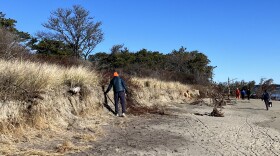Earlier this week, a man in Waitsfield heard a noise in his yard, and looked outside to see a young black bear swinging on his hammock, with another bear watching close by.
He yelled to scare them off, but the bears stayed put.
“Those bears, when somebody stepped out, should have been running,” said David Sausville, a biologist who oversees wildlife management at the Vermont Fish and Wildlife Department.
Their lack of fear is part of a pattern of black bears learning they can get an easy meal from people's homes — whether that’s from bird feeders, garbage cans, chicken coops or compost.
“Once they learn it's there, they teach their young and it just keeps a bad cycle going,” Sausville said.
So far, the state has received over 400 reports of bear incidents since the early weeks of March, which is high for this time of year. Those complaints have ranged from bears combing through restaurant dumpsters to breaking into people’s homes and peeling apart cars.
In northern New Hampshire, a mother bear was killed by state wildlife officials this week after repeatedly entering a home and acting aggressively as a man tried to take out his trash, according to reporting by New Hampshire Public Radio.
In Vermont, 26 bears were killed by the state in 2022. That same year, over 1,500 bear incidents were reported.
The rise in bear conflicts isn’t because there are more bears — the population in Vermont has been fairly stable in recent decades. Sausville said people have moved into more rural areas in the state. More are working from home — and are more likely to see bears. And bears are increasingly associating people's homes with food.
He said Vermonters need to get rid of attractive food sources like bird feeders and trash cans left out at night and make it more uncomfortable for bears who wander near people’s homes — with loud noises like air horns, banging pots and pans and even rubber bullets.
“If you don't get those negative reinforcements, they just get used to being around humans, and it doesn't scare them off.”
Have questions, comments or tips? Send us a message.




